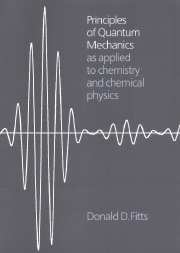Book contents
- Frontmatter
- Contents
- Preface
- Chapter 1 The wave function
- Chapter 2 Schrödinger wave mechanics
- Chapter 3 General principles of quantum theory
- Chapter 4 Harmonic oscillator
- Chapter 5 Angular momentum
- Chapter 6 The hydrogen atom
- Chapter 7 Spin
- Chapter 8 Systems of identical particles
- Chapter 9 Approximation methods
- Chapter 10 Molecular structure
- Appendix A Mathematical formulas
- Appendix B Fourier series and Fourier integral
- Appendix C Dirac delta function
- Appendix D Hermite polynomials
- Appendix E Legendre and associated Legendre polynomials
- Appendix F Laguerre and associated Laguerre polynomials
- Appendix G Series solutions of differential equations
- Appendix H Recurrence relation for hydrogen-atom expectation values
- Appendix I Matrices
- Appendix J Evaluation of the two-electron interaction integral
- Selected bibliography
- Index
- Physical constants
Chapter 7 - Spin
Published online by Cambridge University Press: 05 June 2012
- Frontmatter
- Contents
- Preface
- Chapter 1 The wave function
- Chapter 2 Schrödinger wave mechanics
- Chapter 3 General principles of quantum theory
- Chapter 4 Harmonic oscillator
- Chapter 5 Angular momentum
- Chapter 6 The hydrogen atom
- Chapter 7 Spin
- Chapter 8 Systems of identical particles
- Chapter 9 Approximation methods
- Chapter 10 Molecular structure
- Appendix A Mathematical formulas
- Appendix B Fourier series and Fourier integral
- Appendix C Dirac delta function
- Appendix D Hermite polynomials
- Appendix E Legendre and associated Legendre polynomials
- Appendix F Laguerre and associated Laguerre polynomials
- Appendix G Series solutions of differential equations
- Appendix H Recurrence relation for hydrogen-atom expectation values
- Appendix I Matrices
- Appendix J Evaluation of the two-electron interaction integral
- Selected bibliography
- Index
- Physical constants
Summary
Electron spin
In our development of quantum mechanics to this point, the behavior of a particle, usually an electron, is governed by a wave function that is dependent only on the cartesian coordinates x, y, z or, equivalently, on the spherical coordinates r, θ, ϕ. There are, however, experimental observations that cannot be explained by a wave function which depends on cartesian coordinates alone.
In a quantum-mechanical treatment of an alkali metal atom, the lone valence electron may be considered as moving in the combined field of the nucleus and the core electrons. In contrast to the hydrogen-like atom, the energy levels of this valence electron are found to depend on both the principal and the azimuthal quantum numbers. The experimental spectral line pattern corresponding to transitions between these energy levels, although more complex than the pattern for the hydrogen-like atom, is readily explained. However, in a highly resolved spectrum, an additional complexity is observed; most of the spectral lines are actually composed of two lines with nearly identical wave numbers. In an alkaline-earth metal atom, which has two valence electrons, many of the lines in a highly resolved spectrum are split into three closely spaced lines. The spectral lines for the hydrogen atom, as discussed in Section 6.5, are again observed to be composed of several very closely spaced lines, with equation (6.83) giving the average wave number of each grouping.
- Type
- Chapter
- Information
- Principles of Quantum MechanicsAs Applied to Chemistry and Chemical Physics, pp. 194 - 207Publisher: Cambridge University PressPrint publication year: 1999
- 1
- Cited by

